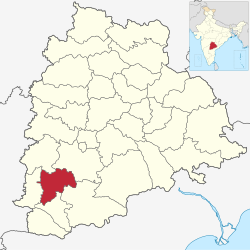Mahabub Nagar district
Mahabubnagar district | |
|---|---|
 Mallela Theertham waterfall | |
 Location of Mahabubnagar district in Telangana | |
| Country | |
| State | File:Government of Telangana Logo.png Telangana |
| Headquarters | Mahabubnagar |
| Tehsils | 21 |
| Government | |
| • District collector | S Venkata Rao |
| Area | |
| • Total | 2,738 km2 (1,057 sq mi) |
| Population (2011)[1] | |
| • Total | 919,903 |
| • Density | 340/km2 (870/sq mi) |
| Time zone | UTC+05:30 (IST) |
| Vehicle registration | TS–06[2] |
| Website | mahabubnagar |
Mahabubnagar district is a district in the Indian state of Telangana. Mahabubnagar is the district headquarters which is popularly known as Palamoor.[3] The district shares boundaries with Narayanapet, Vikarabad, Rangareddy, Nagarkurnool, Wanaparthy and Jogulamba Gadwal districts. The district was formed during the period of the 6th Nizam of Hyderabad State – Nawab Mir Mahbub Ali Khan and hence named after him.
Etymology[edit]
Mahabubnagar was formerly known as Palamoor, meaning "land of milk" due to its milk production.[4] The name was changed to Mahabubnagar on 4 December 1890, in honour of Mir Mahbub Ali Khan Asaf Jah VI, the Nizam of Hyderabad (1869–1911 AD).
History[edit]
The area that forms current Mahabubnagar district has held historic significance. It was under Janapada rule by 6th century BCE, and later was Maurya territory. The region was at the core of the Satavahana dynasty from 221 BCE to 218 CE, and also a large part of the Chalukya dynasty from the 5th to the 11th century CE. The region was later part of the Kingdom of Golkonda (c. 1364 – 1512), with its capital city Golkonda located near Hyderabad.
In 1518 it came under control of the Qutb Shahi dynasty, which reigned until 1687. The region was then a part of Hyderabad State, ruled by the Asaf Jahi Dynasty, from 1724 to 1948.
Geography[edit]
Mahabubnagar district is spread over an area of 2,737.00 square kilometres (1,056.76 sq mi).[5] The Krishna river flows through the district, as well as the Tungabhadra. They merge at Sangameswaram.
Demographics[edit]
As of 2011[update] Census of India, the district has a population of 919,903.[1] The official language of the district is Telugu and the second official language is Urdu. Scheduled Castes and Scheduled Tribes make up 14.1% and 11.5% of the population respectively.
Jain temple[edit]
The oldest terracotta style Jain temple is in Alvanpalli village of Mahabubnagar district. This temple was built between 7th and 8th century. This temple is one of the two such structures in India other built during Gupta period is located at Bhitargaon under Kanpur district, Uttar Pradesh. This temple was built using bricks made of burnt clay. The large bricks of the temple were plaster using the limestone. The principal deity of the temple was Mahavira.[6] The temple was around 18th century, since no efforts were being made to conserve it the rare structure the sculptures of Mahavira, Parsvanatha and few other historical importance had been moved to a local museum in Pillalamarri and some to the State Museum in the city.[7]
Economy[edit]
In 2006 the Indian government named Mahabubnagar one of the country's 250 most backward districts (out of 640 total).[8] It is one of the 9 districts in Telangana currently receiving funds from the Backward Regions Grant Fund Programme (BRGF).[8]
Administrative divisions[edit]
The district has one revenue divisions of Mahabubnagar. These are sub-divided into 15 mandals.[5] S Venkata Rao is the present collector of the District.[9]
Notable people[edit]
- V. Srinivas Goud – politician
- Suravaram Pratapareddy – social historian
- Burgula Ramakrishna Rao – former Chief Minister of Hyderabad State
- Devarakonda Vittal Rao – politician
- Jaipal Reddy – politician
- Nagam Janardhan Reddy – politician
- Venkatarama Reddy - kotwal
- Goreti Venkanna – singer
- B. Venkateshwarlu – writer and journalist
Education[edit]
Mahabubnagar district falls under the jurisdiction of Osmania University and Palamuru University.[10] The district has many government and private medical college, junior, undergraduate and graduate colleges.
See also[edit]
References[edit]
- ↑ 1.0 1.1 "At A Glance | Mahabubnagar District,Telangana | India". Retrieved 15 September 2020.
- ↑ "Vehicle Registration Codes For New Districts In Telangana". Sakshipost. Retrieved 16 February 2019.
- ↑ "Official website of Mahabubnagar district". National Informatics center. Retrieved 14 August 2015.
- ↑ "Mahabubnagar-NIC". mahabubnagar.nic.in.
- ↑ 5.0 5.1 "New districts". Andhra Jyothy.com. 8 October 2016. Retrieved 8 October 2016.
- ↑ "The last of the 2 brick temples". Deccan Chronicle. 30 September 2018. Retrieved 15 November 2020.
- ↑ "Unique Jain temple in Telangana lies in ruins". The Hans India. 30 April 2017. Retrieved 16 February 2019.
- ↑ 8.0 8.1 Ministry of Panchayati Raj (8 September 2009). "A Note on the Backward Regions Grant Fund Programme" (PDF). National Institute of Rural Development. Archived from the original (PDF) on 5 April 2012. Retrieved 27 September 2011.
- ↑ "K Chandrasekhar Rao appoints collectors for new districts". Deccan Chronicle. 11 October 2016. Retrieved 13 October 2016.
- ↑ "Palamuru University". palamuruuniversity.ac.in.

